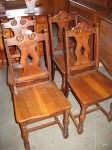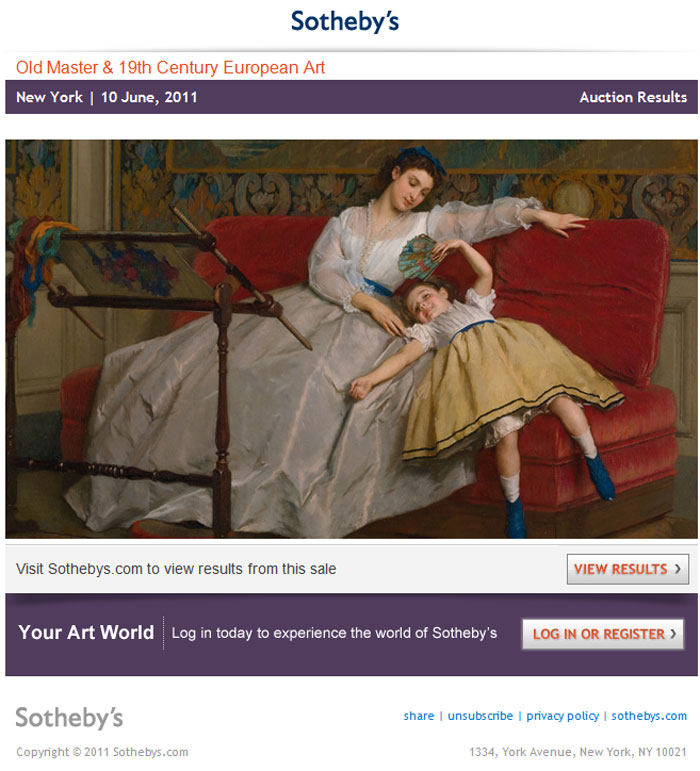Archive for June, 2011
Sotheby’s – Wine
June 23rd, 2011 by adminSotheby’s Contemporary Art Evening Auction
June 23rd, 2011 by adminThe Contemporary Art Evening Auction on 29 June in London will present a selection of works of major significance, including 34 lots from The Duerckheim Collection, the most important private collection of post-war German Art ever to be offered for public sale. The Duerckheim Collection includes early and formative masterpieces by Georg Baselitz, Gerhard Richter, Sigmar Polke, Blinky Palermo and several others, which document their exhilarating advancements of the 1960s. The appearance of paintings of this quality, art historical significance and freshness to market is exceptionally rare and represents a very special auction moment.
Matchlock
June 18th, 2011 by admin
Military firearms are highly collectible antiques that peak a lot of buyers interests. One rare antique that fits this category is the matchlock weapon. The matchlock first came into existence in the 14th century. The significance of the matchlock was that it had a mechanism or “lock” invented to facilitate the firing of a hand-held firearm. Its design removed the need to lower by hand a lit match into the weapon’s flash pan. The matchlock also made it possible to have both hands free to keep a firm grip on the weapon at the moment of firing, and, more importantly, to keep both eyes on the target.



The classic European matchlock gun held a burning match in a gun that was known as the serpentine. A variety of matchlock was also developed called the snapping matchlock, in which the serpentine was spring-loaded and released by pressing a button, pulling a trigger, or pulling a short string passing into the mechanism. This type fell out of favor with soldiers, but was often used in fine target weapons. One weakness of the matchlock was the necessity of keeping the match lit. The sole source of ignition for the powder was the match. If the match was not lit, then the mechanism was useless and the gun became little more than an expensive club. This was mainly a problem in wet weather for the matchlock gun. It became an issue when the damp match cord was difficult to light and to keep burning. Another drawback was the burning match itself. At night, the match would glow in the dark, possibly revealing the carrier’s position. The distinctive smell of a burning match-cord was also a dead giveaway of a musketeer’s position. This was one reason why soldiers in charge of transporting and guarding ammunition were amongst the first to be issued self-igniting guns like the wheel lock and snaphance. The matchlock was also uneconomical to keep ready for long periods of time. The matchlock first appeared in Europe in the middle of the 15th century. By the 16th century, the matchlock was universally sold everywhere. The Janissary corps of the Ottoman army adopted matchlock arms from Hungary gradually from the 1440s onwards. Improved versions of the musket were transported to India by Babur in 1526 and then to Japan by the Chinese. The Japanese were technically able to produce tempered steel such as swords and blades. However, they preferred to use work-hardened brass springs in their matchlocks. The low cost of production, simplicity, and high availability of the matchlock kept it in use in European armies until about 1720. Both the Qing Dynasty and the Joseon Dynasty used matchlock arms as late as the 1850s and 1870s. They used these during the Second Opium War and the United States expedition to Korea. Improvised matchlock guns were last used by pro-Indonesia Timor Leste militias in the 1999 conflict.
Dan Ripley’s Antique Helper – June 18th Art and Antiques Auction
June 17th, 2011 by adminAn early summer auction featuring an eclectic mélange of fine art, antiques and other delights selected especially to make your summer an inspiration to all.
June Art and Antiques Auction
Saturday, June 18
10 AM EST
Auction Preview:
Friday, June 17 2-6 PM
Stokesay’s Castle
June 17th, 2011 by admin
John Taylor Arms’s “Stokesay Castle”, is a world famous historical antique. Arms created this etching and work of art in 1942. It is printed on black on blue-green handmade laid paper. The image presents a side view of the famed thirteenth-century fortified manor house located in Shropshire, England. The scene shows the castle and adjoined church next to it. It is pencil signed and dated the year 1942. The print is titled and inscribed “To my friends Mr. and Mrs. Robert D. Smith with Best wishes from John Taylor Arms 1942.” The technique used is engraving. Overall, this exquisite print is inexpensive and in very good condition.

From the Norman Conquest until 1241, the area was held by the Lacy family, a powerful dynasty with lands in the Welsh Marches. Stokesay Castle is a fortified manor house in Shropshire, England. It was built in the late 13th century. Stokesay Castle is a grade 1 listed building, which means it has been placed on the Statutory List of Buildings of Special Architectural or Historic Interest. This gigantic fortress was owned by the Lacy family. On the death of the last male heir, Walter de Lacy, it was left to the husbands of his two granddaughters to divide the family estates. The Stokesay Castle manner went to John de Verdon. Verdon went on a crusade leaving his property to a tenant. This tenant sold the manor in 1281 to Laurence of Ludlow. The main construction of Stokesay Castle was undertaken by Ludlow, the richest local wool merchant of his generation. Extensive research done on Stokesay Castle’s structure was done and concluded that virtually the whole present structure was completed before 1291. One of the oldest elements of Stokesay Castle is the lower two story’s of the north tower. One of Stokesay Castle’s most magnificent features is its great slate-roofed hall, which stands thirty-four feet high. The original wooden staircase also remains intact today. The Elizabethan gatehouse, added in the 16th century, is also half-timbered and is decorated with elegant carvings. The interior of the castle contains a selection of rare wall paintings from the medieval period.
During the reign of King Charles I, Stokesay’s Castle fell into the ownership of a different family and was used for a supply base for the King’s forces in the area, in the early stages of the English Civil War. The manor was used as a farmhouse and a barn until the early nineteenth century. In 1869, it was purchased by John Derby Allcroft. Allcroft, realizing the historical significance of Stokesay’s Castle, set about to restore and maintain it. He also had Stokesay’s Court built nearby. Stokesay’s Castle is currently in the guardianship of the English heritage, which provides a recorded audio tour of the entire premises for visitors. This is a print that will add nicely to an antique collection for any collector.
Sotheby’s – Impressionist & Modern Art Evening Sale
June 17th, 2011 by adminSotheby’s – Old Master & 19th Century European Art
June 17th, 2011 by adminJacobean Furniture
June 16th, 2011 by admin
Jacobean furniture dates all the way back to the year 1600. The revival of this style lasted for almost a century. The period represents the growth of foreign influence and the passing of the oak styles. The Jacobean style was made popular during the reign of James the first and was also popular under his son Charles the second.
The earliest Jacobean furniture was influenced mainly by Elizabethan (1603 -1688) styled furniture. During this time the furniture took on different styles. Early Jacobean furniture was somewhat inward looking, not fully embracing exotic influences that were more ornate. Colonial Americans copied the early styles of the furniture as best as they could since they did not have skilled furniture makers.
Commonwealth Style (1649-1660) marks the middle of the Jacobean Period, when the furniture was of simpler design and undecorated. The late Jacobean Period is that of the Carolean period, named for King Charles II. Charles the first was more cultured than his father and took much care and interest in the furnishings of his palaces and mansions and especially in the collection of great art and paintings. During Charles’s reign over England, he paid more attention to domestic comfort with much more use of padded upholstery, carpets instead of rush mats, and finer embroidery. The Latin name for James is Jacobus. The English style in vogue beginning with James I’s reign is referred to as “Jacobean”. The Jacobean, or Jacobethan, era was another phase of English Renaissance architecture, theatre, and decoration and formed a continuation, begun in the Elizabethan age, of the Renaissance’s penetration into England. In America, Jacobean style furniture is synonymous with Pilgrim style because the early English settlements in America took place during the Jacobean era. Very little American furniture of the earlier part of the Jacobean period is still surviving; but later pieces, from about 1670, are more numerous. Most of the American primitive furniture was produced during this period by colonists to make do, because there were few skilled cabinetmakers in the colonies.
There were many different features in the Jacobean furniture style. Oak was the chief wood and Ash and maple were used for turning and whittling. Using pine wood was also a popular method. There were also a few different types of Jacobean furniture. This included turned chairs, highly carved mirror frames, footstools, and gateleg tables. Upholstery was used to improve chairs. Upholstery is the work of providing furniture, especially seats, with padding,springs,webbing and fabric covers. Materials such as silk, tapestries, crewelwork, linen, velvet, and even leather were used on various types of chairs. There were four different chair styles in the Jacobean era that included three-legged, carver, and Brewster. Almost all flat surfaces on chairs, chests, etc. are carved in low relief. Jacobean furniture was very sturdy, massive in size, notoriously uncomfortable, and made to last. The furniture pieces that were produced consisted mainly of chests, cupboards, trestle tables, wainscot chairs, and gate legged circular tables. Some veneering and inlay were used, and many pieces were painted. Spiral turning was also very popular. Tables were rectangular in shape, with small melon ball turning on the legs. As a rule, Jacobean furniture construction was simple. It was assembled with mortise and tenon joints, held together with pegs.
Jacobean period furniture can mainly be found in the auction houses of England. Being built to last, many pieces have not only survived, but are still in good condition. Understandably expensive, most “Jacobean antiques” available for sale are actually 19th century reproductions. Lines of furniture today have the same styles and will reference the Jacobean era.

|

|

|

|

|

|

|

|

|









